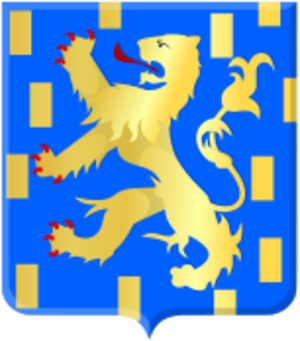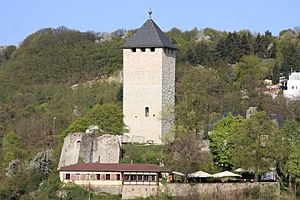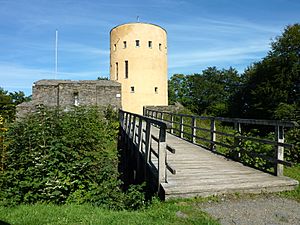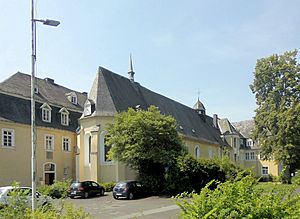Henry II, Count of Nassau facts for kids
Quick facts for kids
Henry II, Count of Nassau
|
|
|---|---|
| Born | c. 1180 |
| Died | 26 April 1247/48/49/50 |
| Noble family | House of Nassau |
| Spouse(s) | Matilda of Guelders and Zutphen |
| Issue | Walram II, Count of Nassau Otto I, Count of Nassau Henry Elizabeth Gerhard of Nassau John I, Bishop-Elect of Utrecht |
| Father | Walram I of Nassau |
| Mother | Kunigunde |
Henry II "the Rich" of Nassau (born around 1180 – died April 26, between 1247 and 1250) was a powerful Count of Nassau. He was known for being brave and very religious. Henry was also very generous, giving a lot of money to churches and monasteries. This helped religious places in his area grow a lot during his time. He especially supported the Teutonic Order, a group of knight-monks. Henry also took part in the Sixth Crusade, a big religious journey. He is famous for building important castles like Sonnenberg, Ginsburg, and Dillenburg.
Contents
Life of Henry II
Henry II was the oldest son of Count Walram I of Nassau and a woman named Kunigunde. He is first mentioned in official papers in 1198. At that time, he was already considered an adult, which meant he was at least 12 years old.
Henry was the Count of Nassau from 1198 to 1247. For some years, until 1230, he ruled alongside his brother, Rupert IV.
Henry's Role in the Holy Roman Empire
Henry was usually a loyal supporter of the Hohenstaufen emperors, who ruled the Holy Roman Empire. However, for a short time between 1209 and 1211, he supported a different emperor, Otto IV. But he soon switched back to supporting Frederick II.
Henry even held Frederick's opponent, Archbishop Theodoric II of Trier, as a prisoner for two years. He often met with Emperor Frederick II and his son, Henry. In 1228, Henry joined Emperor Frederick II on the Sixth Crusade, a military expedition to the Holy Land.
Later in his life, Henry changed his loyalty to the Pope. Because of this, Frederick's son, Conrad IV, ordered his arrest in 1241. In 1247, Henry supported a new king, William II of Holland. King William confirmed all of Henry's lands and even gave him the right to make his own coins.
Local Power and Conflicts
Henry's father had received the royal estate of Wiesbaden from Emperor Frederick I. Around 1214, Henry expanded Nassau's lands in this area. He gained control over Wiesbaden and the surrounding region.
Around 1200, Henry and his brother Rupert started building Sonnenberg Castle. This castle was meant to protect their lands from the Archbishop of Mainz and his allies. However, the church in Mainz claimed the land where Sonnenberg Castle was built. To solve this, Nassau paid money to the church in 1221. They also agreed that the Archbishops of Mainz would have some control over Sonnenberg.
In 1224, Henry got help from Engelbert II, the Archbishop of Cologne. In return, Henry had to give half of Siegen to Cologne. But Nassau still kept its ruling rights in the Siegerland region, including important legal and hunting rights.
Henry fought many battles during his rule. He had conflicts with other noble families over lands like Siegen. In the Siegerland, he built Ginsburg Castle to strengthen his control.
Henry's brother, Rupert, joined the Teutonic Order in 1230. When Rupert died in 1239, he left his inheritance to the Order. Henry often disagreed with the Teutonic Order about how to divide his brother's lands.
Henry also had control over the church in Limburg an der Lahn while Limburg Cathedral was being built. In 1239, he gave the income from the churches in Netphen to the Keppel Abbey, a monastery near Hilchenbach. His family continued to support this monastery for many years.
Henry's actions in the Herborner Mark area made some local noble families angry. Around 1240, Henry built Dillenburg Castle to better control these families. This led to a long-lasting conflict called the Dernbacher Feud. This feud also involved Hesse and lasted for centuries, even after Henry's death.
Henry died on April 26, sometime between 1247 and 1250. He is mentioned in a document from 1247, but by January 25, 1251, he was listed as deceased. He was buried at Arnstein Abbey. His sons, Walram II and Otto I, took over as Counts of Nassau after him.
Family Life
Before December 11, 1215, Henry married Matilda of Guelders and Zutphen. Matilda was the youngest daughter of Count Otto I of Guelders and Zutphen. She died on October 28, 1247, or later.
Henry and Matilda had many children:
- Rupert (died before 1247): He was a knight of the Teutonic Order.
- Walram II (born around 1220 – died 1276): He became Count of Nassau after his father. Walram is the ancestor of one main branch of the House of Nassau.
- Otto I (died between 1289 and 1290): He also became Count of Nassau after his father. Otto is the ancestor of the other main branch of the House of Nassau.
- Henry (died after 1247): He became a monk at Arnstein Abbey.
- Elizabeth (born around 1225 – died after 1295): She married Gerhard III, Lord of Eppstein.
- Gerhard (died between 1312 and 1314): He was a clergyman.
- John (died 1309): He was chosen to be the Bishop of Utrecht.
- Catharine (died 1324): She became the head nun (Abbess) of Altenberg Abbey in 1249.
- Jutta (died 1313): She married John I, Lord of Cuijk.
- Irmgard (died 1297): She was the head nun (Abbess) of Val-Benoît.






